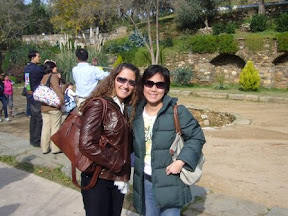 During November 23-30, 2007, P.Ou and I went to Turkey. The tour was arranged by Turkish Airlines to visit famous places of Turkey.
During November 23-30, 2007, P.Ou and I went to Turkey. The tour was arranged by Turkish Airlines to visit famous places of Turkey.We departed Bangkok almost midnight of November 23, and November 24, second day of tour, we landed in Istanbul and took domestic flight to Izmir, then traveled by bus to Selçuk. We visited House of Virgin Mary, Ancient city of Ephesus, and stay at hotel close to the Aegean Sea.
Day 3, we traveled to Pamukkale.
Day4, we tool trip to Konya and to Cappadocia.
Day 5, we traveled around Cappadocia, then to Kayseri to took a flight to Istanbul.
Day 6-7, we traveled around Istanbul area.
Please see more photos in Turkey at http://picasaweb.google.com/arthivon/Turkey2007#
Tuba, local guide and Khun Kai Nui who was Thai guide, chef, photographer, and etc.



















































